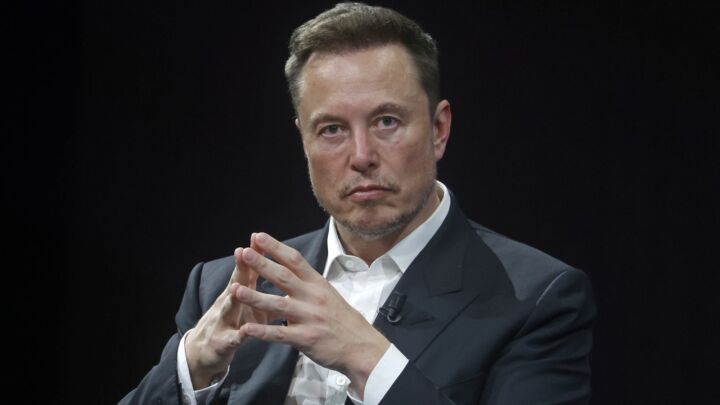Tony Blair: man or myth?
In place of politics, New Labour gives us symbols and narratives.

Politics…is surely about more than this?’
In the UK Independent, eminent commentator Donald MacIntyre regretted the time and energy devoted to the row over Blair ‘muscling in’ on the Queen Mother’s funeral. The status of the issue, he observed, had reached ‘risible’ proportions (1).
The following morning, the Independent reported home secretary David Blunkett’s remarks about the ‘febrile’ atmosphere in which the media coverage of politics had ‘almost reached the edge of insanity’. The day after that, in the first of his presidential-style press conferences, prime minister Tony Blair distanced himself from the ‘Westminster Village’ and its destructive spin scandals, calling for ‘time out on hysteria’.
There is much concern about the incestuous character of the Westminster Village. The most vocal critics of Village life are the Villagers themselves – politicians and pundits alike. But the more they long to escape, the more they are locked in. The very events that most Villagers would wish never to be repeated, demonstrate why such events are likely to occur again and again. The tale of Blair and Black Rod is a case in point.
In April 2002, the Spectator‘s political editor Peter Oborne contrasted Blair’s central part in the mourning of Princess Diana in 1997 to his marginal role in the Queen Mother’s funeral earlier this year. Downing Street officials apparently applied ‘sustained and constant pressure’ in an attempt to cast Blair in a central role, but were rebuffed by General Sir Michael Willcocks, Gentleman Usher of the Black Rod, Sergeant at Arms to the House of Lords, and master of state ceremonies.
In this episode, Black Rod is the man wearing a costume of breeches and silk stockings. But Blair is the real actor, desperate to take centre stage in a repeat of his post-Diana performance.
When Diana’s corpse was brought to England from Paris, Blair’s televised remarks set the tone for a week of public mourning. His reference to the ‘people’s princess’ not only upstaged the Queen, but prompted a series of dramatic tableaux in which Diana became associated with the New Britain premiered by New Labour. If Diana was the star of this week-long melodrama, Blair was her leading man. And he gave the best performance of his first term of office.
In this context, ‘performance’ is not merely metaphorical – it is an exact description of the prime minister’s changing function.
Here was a prime minister devoid of politics. In this, the key event of New Labour’s first term, there was no contest of competing policies or views, no case to be put for one policy or another, no argument to be won or lost. Aristotle identified three elements as co-prerequisites for politics – logos (line of argument), pathos (mood music) and ethos (moral character). In a context with no need for logos, Blair just provided pathos and ethos. He turned the political office of prime minister into a non-political role more akin to the parts played by priests in the past and more recently by icons of popular culture like film and pop stars.
Formally speaking, Blair is still a politician – but his role is essentially different from that of previous prime ministers. Instead of analysis and agency, he offers symbols and narratives; iconography rather than ideology. Where his predecessors sought to act in accordance with a coherent worldview, Blair seeks to act out the hopes and fears of his audience, the electorate. Like any star, he needs a vehicle. Blair’s purchase on public perception depends on big scenes like the ones he played after Diana’s death.
Seen in this light, the pressure that Downing Street applied on Black Rod makes more sense. This was no mere tussle over courtly rank and etiquette. Pictures of Blair walking through the sombre crowd to Westminster Hall, and greeting the Queen on her arrival there, could have been as iconic as the five-year-old footage of his elegy to Diana. Not only the chosen servant of New Britain, represented by Diana, Blair would also have configured himself as the favourite son of the old and venerable, symbolised by the Queen Mother.
The magic of such imagery is that it transcends social divisions and constructs a sense of unity, albeit temporary and one-dimensional. It fulfils the function of myth in pre-modern times. Indeed, in this sense, Tony Blair is a myth: a supernormal image and an inclusive narrative with the power to bring people together on an emotional level.
Constructing the Blair myth has been New Labour’s biggest success. But the fact that the Blair myth has had to be constructed is also New Labour’s most significant weakness.
In the pre-modern period, myths developed organically, across the mists of time. They were never the invention of a named author, but were simply handed down from one generation to the next. In the past, it was the apparent timelessness of myths that gave them their salience and significance.
But in today’s postmodern times, the Blair myth is the result of immediate artifice, not gradual evolution. ‘Blair’ is the protagonist in an inclusive narrative not merely recorded but invented by an exclusive coterie of New Labour authors – including Blair himself, Alastair Campbell, Peter Mandelson and others. Yet a manufactured myth is a contradiction in terms, and its icons are highly susceptible to iconoclasm. That’s why Downing Street was so sensitive about the pressure it applied to Black Rod. Peter Oborne’s story pointed to the artificial character of the Blair myth – and as such, it was an attack on the authenticity of the myth and undermined its credibility.
This is the most dangerous moment for New Labour. ‘Myth’ in the anthropological meaning of the word (supernormal image and inclusive narrative) is supplanted by its popular usage as a misleading facade that thrives on manipulation.
Myth is not only a powerful tool for the construction of New Labour, but also a self-destructive weapon. Within New Labour circles, the drive towards mythmaking was itself derived from the end of Big Ideas in politics. Where once the smallest policy step was always traceable to a Big Idea, today policy is ‘post-ideological’ and politics is merely managerial. So the unity of modern politics, in which class interests combined with rational arguments to produce policy and ideology, has been superseded by a postmodern split between managerialism and mythmaking.
Both have their origins in the end of Big Ideas and the suspension of class conflict, and each is the necessary consequence of the other. As long as one continues, so will the other – and the disjuncture between the two will be a recurring problem.
The Blair myth is New Labour’s attempt to move on from discredited ideology and at the same time transcend the narrow confines of managerialism. But, as the Black Rod episode shows, even the myth has to be managed; and, despite Donald MacIntyre’s yearning for something ‘more than this’, its mismanagement is now what passes for politics.
These are the morbid symptoms of life in the Village of the Damned.
Andrew Calcutt is the author of Brit Cult: An A-Z of British Pop Culture, Prion Books, 2000 (buy this book from Amazon (UK) or Amazon (USA)); Arrested Development: Pop Culture and the Erosion of Adulthood, Continuum International Publishing Group, 1998 (buy this book from Amazon (UK) or Amazon (USA); and White Noise: An A-Z of the Contradictions in Cyberculture, Palgrave Macmillan, 1998 (buy this book from Amazon (UK) or Amazon (USA)). He is also coauthor of Cult Fiction: A Reader’s Guide, Prion Books, 1998 (buy this book from Amazon (UK) or Amazon (USA)).
Read on:
Image wars, by Josie Appleton
To enquire about republishing spiked’s content, a right to reply or to request a correction, please contact the managing editor, Viv Regan.








Comments
Want to join the conversation?
Only spiked supporters and patrons, who donate regularly to us, can comment on our articles.